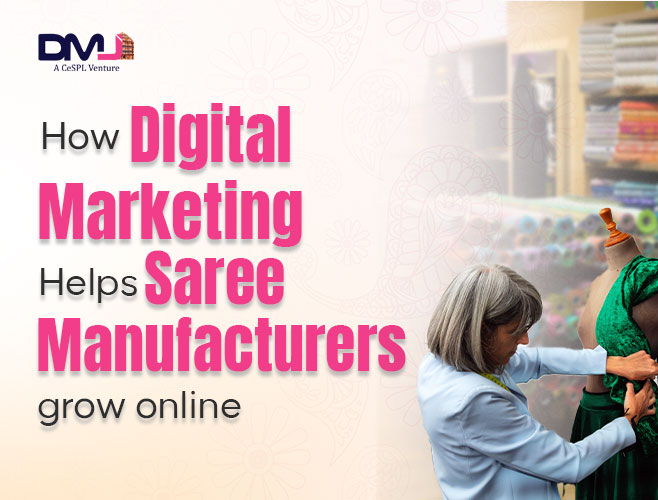The Indian saree industry is no longer just a tradition; it has evolved into an economic hub with considerable domestic and international demand. Banarasi or Bandhani, every saree is a cultural and artistic expression. The manufacturer faces numerous growth opportunities due to digitalization and the emergence of e-commerce, which brings about new shopping trends.
However, to truly take a saree business to new heights, creating a good product alone will not suffice; it needs a smart strategy, a deep understanding of the market, and contemporary marketing tools. In this blog, we will take you through more modern avenues and provide you with some ideas, with Jaipur and Surat being the primary hubs for sarees.
A Roadmap to Understanding the Saree Market
Saree markets in India blend conflicting notions of tradition and fashion. This market caters to a diverse range of consumers, spanning from rural women to sophisticated urban fashionistas. According to Statista, the growing demand and price trends indicate that the Indian ethnic wear market is expected to reach INR 1.7 trillion by 2025, with female sarees holding a significant share.
New-age fabric blends, modern draping styles, and the rise of e-commerce have influenced consumer preferences. Cities like Jaipur are famous for Bandhani and Kota Doria sarees, while Surat stands as India’s biggest center for synthetic and embroidered sarees. For scaling, one must capitalize on regional demands, festival peaks, and bridal trends. Whatever comes to mind, whether in the wholesale or designer segment, being able to identify your target segment is key to growth.
Saree Production & Manufacturing: Explore the Indian Market
The Indian saree manufacturing industry caters to both handloom and power loom. One major manufacturing center for synthetic sarees is located in Surat, which, according to some studies, produces millions of meters of synthetic sarees each day. Surat hosts nearly 450 textile dyeing and printing mills, in addition to thousands of embroidery units, and primarily caters to wholesalers and retailers across India and abroad.
On the other hand, the manufacturing ecosystem in Jaipur caters mainly to artisans. Bandhej, Gota Patti, and several hand block prints dominate this production landscape. There are many local artisans and small-scale manufacturers in semi-urban clusters who produce these textiles using traditional methods. The Ministry of Textiles, along with schemes such as SAMARTH (Skill Development) and the Amended Technology Upgradation Fund Scheme (ATUFS), promotes modernization. With India being the second-largest textile producer in the world, the manufacturers of sarees witness huge market potential to upscale via:
- Adoption of digital looms
- Supply chain logistics
- E-commerce integration
The physical exhibition-based setup is now disrupted by the creation of distribution via virtual showrooms. The new-age system provides a channel for manufacturers to target global buyers.
Indian Saree Manufacturers: Where to Find Them?
Finding a safe and efficient manufacturer is one of the critical steps in the saree business, whether a wholesale outlet aims to scale up, a retailer seeks to increase inventory, or a start-up is trying to finalize a brand name. Among the numerous manufacturing options, Surat and Jaipur come up as the two leading manufacturing hubs in the country.
-
Surat: Synthetic Saree Capital
Surat leads in the production of synthetic and embroidered sarees; hence, it is also known as a textile city. It boasts the largest polyester production units in India and has over 450 textile dyeing and printing mills, as well as thousands of units for embroidery and finishing.
Markets like the Ring Road, Begumpura, and Millennium Market are full of saree wholesalers and exporters who deal in bulk quantities. The Surat Textile Market Association (STMA) was established to regulate prices and ensure the seamless functioning of B2B operations. Manufacturers here supply goods required for pan-India consumption, as well as for exports to the Middle East, Bangladesh, and Sri Lanka.
-
Jaipur-The Ethnic Handcrafted Hub
Jaipur, with its deep artisan tradition, is known for handcrafting sarees in time-honored styles. Among them are Bandhani, Leheriya, Bagru printing, and Gota Patti work. Primarily, cotton and silk sarees are produced here, highly sought after in the premium and bridal trade internationally. The main textile markets in Jaipur include Bapu Bazaar, Tripolia Bazaar, and Johari Bazaar, among others. The city also hosts handloom and fabric shows, such as Vastra Jaipur and India Handloom Brand Fairs, which showcase collections from traditional artisans and major manufacturers.
However, even in a city rich with craftsmanship, many saree manufacturers face challenges in growing their businesses digitally. One such Jaipur-based saree manufacturer was struggling with ad account issues and inconsistent sales, which impacted on their overall growth.
That’s when they reached out to Digital Marketing Jaipur. With their team of professionals, they have completely revamped the site, optimizing the user experience and making it more engaging and conversion-friendly. From smart performance marketing strategy, to using a mix of campaigns including awareness, traffic, engagement, carousel, catalogue, and retargeting ads, they have achieved a 5.3X (ROAS). Thus, whether you’re a small artisan or a growing textile business, partnering with Digital Marketing Jaipur can help your saree business with outstanding sales.
-
Other Trusted Sources to Find Manufacturers
Apart from city markets, one may come across manufacturers verified on well-known B2B portals, such as IndiaMART, TradeIndia, and Alibaba. One may also attend textile expos, such as Textile India, the Surat International Textile Expo, and the Jaipur Vastra Fair. There are also local textile associations and government directories that can serve as reliable sources for sourcing.
For any startup, Ajmera Trends, Meesho, and Udaan serve as aggregators in easing sourcing with ready-to-sell inventory. In logistics, Udaan tends to focus on scaling from a price point. However, keep in mind the opaque status of MOQ, customization, delivery, and supplier credibility while signing long-term contracts.
SWOT Analysis for the Saree Manufacturer
SWOT Analysis helps the saree manufacturers with the internal strengths and weaknesses, very preliminary awareness of external opportunities and threats. This becomes particularly important when scaling and pursuing sustainable growth.
Strengths
- A Rich Cultural History: With sarees deeply ingrained in Indian culture, their demand is unlikely to wane.
- Handicraftsmen: Unique crafts, such as Gota work, Bandhej, and embroidery, thrive in Jaipur, particularly in this region.
- Government Support: Schemes like ATUFS and MUDRA loans assist in manufacturing, financing, and selling.
- Export Potential: Indian sarees find their way to the international markets, especially in the United States, U.K., and U.A.E.
Weaknesses
- Technology Lagging: Many units are still in manual production, which is inefficient and limits their capacity for scaling up.
- Volatile Cost of Raw Materials: Variations in the prices of raw materials for silk-cotton and synthetic yarns result in fluctuations in pricing and profit.
- Lack of Branding: Most saree businesses lack brand and marketing visibility.
- Unorganized Sector: A significant portion of manufacturers are not GST compliant or are not utilizing digital means of operation.
Opportunities
- Sustainable Fashion Trends: Demand for organic cotton and green dyes will open up new avenues for these manufacturers.
- E-commerce Boom: The global reach has opened up for local manufacturers through platforms like Amazon, Flipkart, and Myntra.
- Fusion Designs: Saree-gowns and Indo-Western styles are quite popular among millennials.
- Influencer Collaborations: The social media landscape has played a crucial role in brand building for sarees among the younger generation.
Threats
- Power-loom Vs. Handloom Competition: Machine-made sarees are cheaper and faster to produce.
- Lack of Skilled Youth: The Younger generation increasingly refuses to consider traditional jobs in textile manufacturing.
- Global Economic Slowdown: Reduces exports and local buying sentiment.
- Fast Fashion Brands: International brands are entering the ethnic wear space with aggressive pricing.
A comprehensive analysis of a saree manufacturer’s SWOT helps the company align its operations with long-term growth strategies, preparing it for changing market dynamics and competition.
Pros and Cons of the Saree Business in India
The business of sarees in India is promising with its rich cultural background and sustained demand. With millions of women opting for sarees for weddings, festivals, and everyday wear, the market shows immense potential. However, like the other sectors, it poses its own set of advantages and challenges—a fertile ground for both positive and negative developments. Thus, an artist needs to understand yet another side of this hypermarket before drawing inside.

Pros
- Large Market: India’s large nationalist and cultural expanse makes sarees among the most versatile garments. Each region has its weave and pattern – Banarasi in Varanasi, Bandhani in Jaipur, Chikankari in Lucknow, and so on. This vast portfolio of varieties enables a business to target diverse customer segments and both national and international markets.
- Appeal to Modern Clients: Alongside being traditional attire, sarees are increasingly being styled with a modern outlook and worn to office parties, destination events, and festive gatherings. This has expanded the boundary of consumers, especially millennials and urban consumers.
- High Margins: Handmade and designer sarees, especially, have profit margins between 30 and 70 percent based on exclusivity and quality. Customization and limited editions attract premium pricing. Moreover, if you’re looking to understand how a Jaipur-based clothing brand achieved a 7X ROAS in just 10 months, be sure to check out our blog.
- Entrepreneurial Freedom: Essentially started from one’s own home with less working capital, thanks to e-commerce. It provides the freedom to scale sources and means of interacting with customers on a budget or according to one’s perception.
Cons
- Intense Competition: The saree market is saturated, from small vendors in the streets of local markets to large online platforms. Standing out requires immense branding, unique products, and innovative marketing.
- Operational Costs: A saree organization has many fixed and variable costs, including sourcing the fabric, pollution, labor, warehousing, packaging, and shipping, which are not optimized well, denting margins.
- Time-Intensive Work: Processes like hand embroidery, dyeing, or stitching eat up time. Ensuring timely delivery becomes a challenge alongside quality assurance in handloom operations.
- Customer Loyalty: Due to various options offered online and offline, it has taken a long time to create relationships with customers. Much of the investment in new brands goes into customer service, return policies, and post-sales support, allowing them to build their reputation.
A thorough understanding by saree entrepreneurs will help better plan, mitigate risk, and strategize options for sustainable growth in the competitive market.
Digital Marketing Jaipur Role in the Growth of Saree
To stand out in the crowded market, a saree business needs to adopt digital tools. Digital Marketing Jaipur provides a tailored solution for textile entrepreneurs.
Why Choose Digital Marketing Jaipur?
- SEO: Rank Your Saree Store on Google.
- Website Development: Design aesthetically pleasing stores that are mobile responsive.
- Social Media Strategy: Can stay today on Instagram Reels, YouTube Shorts, and influencer collaborations.
- Google Ads, Meta Ads: During festival, bridal, and new launch seasons, run targeted advertising campaigns.
Client Success Stories
The network of Digital Marketing Jaipur has enabled more than 100 textile companies to successfully go online, ranging from Bandhej boutiques in Jaipur to exporters in Surat.
One such success story comes from a saree manufacturer based in Jaipur who was struggling with low order volumes and a high RTO (Return to Origin) rate.
After connecting with our expert Digital Marketing Jaipur team, we launched a customized performance marketing strategy, including awareness, traffic, carousel, catalogue, engagement, and retargeting campaigns. The result? A significant improvement in customer targeting and a 4X ROAS. Moreover, if you’re a textile or saree business facing similar issues, such as low sales, high returns, or poor ad performance, don’t wait. Get in touch with Digital Marketing Jaipur and let us help you grow with the right strategy.
Bonus Tips: Top Marketing Tips for a Successful Saree Business
In today’s fast-moving digital world, having just a collection for sale would not be enough. Sometimes, real beauty remains hidden in designs that are never sold due to a lack of visibility. Marketing, therefore, plays a role. Whether you are a conventional agent or an e-commerce seller, innovative and consistent marketing is essential for branding, attracting customers, and fostering repeat business. Below are a few tried-and-tested strategies that will help your saree business soar to new heights.

Tips To Market Sarees Effectively
- Follow Emerging Trends: Fashion is dynamic; similarly, the saree market is. Observe emerging trends at fashion shows and through social media influencers, as well as market feedback, to identify the styles, fabrics, and draping patterns that are in demand. For instance, now in demand are printed organza, pre-stitched sarees, and pastel handlooms. Moreover, if you want to learn how UGC and influencer marketing can boost your saree brand? Don’t miss our blog on the Role of UGC and Influencers in E-Commerce.
- Build an Attractive Website: Your website is marketing your bare-branded store fragrance. Hence, invest in a very neat and productive one. Use good designs and great text for product description, and good photography, preferably with video try-ons. Make the interface clutter-free, with return policies, shipping policies, and customer testimonials all laid out for prospective buyers, from where their trust can be solicited.
One of our Jaipur-based saree manufacturing clients was struggling with inconsistent sales despite having a great product. After teaming up with Digital Marketing Jaipur, they got a complete website revamp and started running performance marketing ads. The result? A 3X ROAS and a steady boost in sales.
- Decide on Marketing Budget: Marketing should be an ongoing activity that needs continuous funding. Choose about 20-30% of your profit to be spent on digital promotion, content creation, influencer partnerships, and paid ads. Having a budget justified for marketing will prevent one from missing out on seasonal highs and festive campaign offers.
- Register on E-commerce Platforms: Whatever product you may carry, don’t limit it to the offline store. These products can be sold over e-commerce platforms such as Shopify, Amazon, Flipkart, Meesho, and WooCommerce. These platforms coordinate with logistics, making scaling extremely easy.
- Email Marketing and WhatsApp Marketing: Generate a database of customers for advertisement and send them promos, discounts, new arrivals, or styling tips via newsletters or WhatsApp. Such messages are generally well-received and encourage return visits.
- Geotargeting of Local Audience: Select cities to run ad campaigns in on Facebook Ads or Google Ads; the primary saree market cities are Jaipur, Surat, Delhi, and Mumbai. The more localized your content is, the higher the conversion will be.
Marketing, however, never ends. With sufficient attention paid to consistency, creativity, and data, the small-scale saree business can quickly become a widely recognized brand. The digital age has brought so much to our table that we must heed these tools, pay attention to the ultimate end-users, and continue to ride the trending carts to see their sarees reaching the right people at the right time.
Conclusion
The world of sarees is a cocktail of tradition, creative flair, and commerce. With a solid plan, effective digital marketing, and insight into market trends, one can very well chart the direction for scaling their saree manufacturing business. Jaipur and Surat still hold significant influence, but the landscape is poised to change as innovation and technology take the lead.
Frequently Asked Questions
1. Which is the best saree brand in India?
Ans. Some of the top saree brands in India include Nalli, Bharat Sthali, and Suta, which are recognized for their exceptional quality, craftsmanship, and innovative designs in both traditional and modern saree styles.
2. Which city is famous for sarees in India?
Ans. Surat is renowned for its synthetics and embroidered sarees, whereas Jaipur is famous for its hand-made traditional designs, including Bandhani, Leheriya, and Gota Patti.
3. What is the difference between wholesale saree manufacturers and suppliers?
Ans. Manufacturers produce sarees directly, often allowing design customization. Suppliers source sarees from multiple manufacturers, offering a broader selection, but may have limited control over customization and quality.

